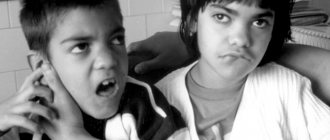Causes and symptoms
The initial sign of the development of a dangerous disease is a rash.
It can appear in the following places:
- sides;
- hips;
- shin;
- Feet;
- knees;
- forearms and hands;
- in rare cases on the face.
The rash appears due to pathogenic bacteria and viruses They cause an inflammatory process in the meninges, and this, in turn, affects the blood vessels. In particular, the capillary membranes are affected.
All this leads to the formation of local hemorrhage. This type of rash is commonly called hemorrhagic. In most cases, it makes itself felt with bacterial meningitis.
Reference! With the viral type of meningitis, immediate damage to the vascular endothelium occurs, which leads to a rash on the baby’s body.
By the way, not all parents pay attention to this symptom. Patients are admitted to the hospital already at the stage when a severe headache makes itself felt, body temperature rises, and frequent vomiting is present.
With meningitis, the rash is called erythema due to its characteristic appearance. Their appearance is explained by the fact that meningococcal toxin blocks blood vessels and increases the permeability of their walls.
How to protect yourself from illness
All parents should pay attention to the prevention of serous meningitis in children. In the summer, you should listen to local news - if an outbreak of meningitis follows after visiting open water, you should not allow your child to swim there.
Measures to combat the disease are generally reduced to maintaining hygiene rules:
- Drink boiled or specially purified water. This rule should be taken especially seriously by those who live in low-lying areas where wastewater may enter the water intake.
- Follow the rules of personal hygiene - be sure to wash your hands after visiting the toilet and before eating.
- Wash vegetables and fruits before eating (especially in the summer). Products can additionally be doused with boiling water - enteroviruses are afraid of high temperatures.
- Meningitis can develop against the background of other viral diseases - measles, mumps, influenza and even common ARVI. Therefore, be attentive to the follow-up treatment and recovery of your child after any such illness.
- If a baby has a weak immune system, he should not come into contact with rodents (even domestic ones), as they are considered carriers of serous meningitis pathogens.
Meningitis is a complex disease. Due to the carelessness of parents, the disease often has the most disastrous consequences. But if you raise the alarm in time and go to a medical facility, serous meningitis will go away quite quickly - in 10-12 days. And don’t forget about prevention – it’s better not to get sick at all.
When the first symptoms of the disease appear, contact an infectious disease specialist online or at a good infectious diseases hospital.
For more information about meningitis in children, watch the video:
This article has been verified by a current qualified physician, Victoria Druzhikina, and can be considered a reliable source of information for site users.
Bibliography
1. https://niidi.ru/dotAsset/e3e1899f-a522-4aa4-acd2-f28dedca3bc0.pdf
Rate how useful this article was
4 3 people voted, average rating 4
Did you like the article? Save it to your wall so you don’t lose it!
What does it look like?
Almost immediately, a characteristic rash can be noticed on the child’s skin.
What does she look like?
At the very beginning, the rash has a red tint, but then turns blue.
In children, rashes appear first on the feet, and then begin to spread throughout the entire skin.
In this case, the child should be hospitalized and antibacterial therapy should be started.
Sometimes individual elements turn into quite large spots.
Meningitis spots are a sign of sepsis . If immediate antibiotic therapy is not started, death can occur.
The rash often becomes pigmented and then disappears. Sometimes crusts form, which are subsequently rejected on their own. In their place, shallow skin defects will remain for some time.
Photo
Read more about the meningitis rash in the photo:
Red rash on back
Why is meningitis dangerous?
Meningitis is expressed in the rapid inflammation of the membrane of the brain, under which serous fluid accumulates. If misdiagnosed, untimely access to doctors and improper treatment, the disease can lead to cerebral edema and result in disability or even death.
Unlike purulent meningitis, serous meningitis is not accompanied by massive death of nerve cells. Therefore, the chances of recovery and a favorable outcome with the serous type of the disease are higher.
Serous and purulent types of meningitis at the cellular level are diseases of opposite nature. It is very difficult to distinguish them externally. In fact, there is only one reliable diagnostic method - lumbar puncture of the cerebrospinal fluid and its subsequent analysis.
First aid for rashes
If a corresponding sign of illness appears, parents should call an ambulance. While doctors are on the way, at home you need to take a number of measures on your own to alleviate the condition of the little patient. This is especially true for residents of rural areas , where the ambulance can take a very long time to travel.
First aid measures:
- It is worth limiting the child’s movement, he must lie down;
- the room where the patient stays must be darkened;
- Don't make noise unless necessary.
Reference! If the patient wishes, he can be given mineral water or tea with sugar to drink. Drinking should be plentiful.
Doctors allow the temperature to be lowered, especially if it is not possible to promptly show the baby to a specialist. In addition, you can give an injection of the lytic mixture.
In this case, headache medications will be ineffective. Parents can perform wet wipes, but only if the temperature in the room is not lower than 20 degrees.
Other signs of illness
A rash is considered far from the only sign of an infectious disease.
Knowledge of the clinical picture of the disease will help distinguish it from others.
The main symptoms here are:
- heat;
- headaches . They are often accompanied by nausea and vomiting, double vision and blurred vision. Sometimes there is a reaction to loud sound and bright light.
- In infants, a bulging fontanel . However, if it is overgrown, then this sign does not make itself felt.
- "cop dog" pose. This symptom is perhaps the most characteristic. In this case, the child is forced to lie on his side, with his leg bent and his back arched. This position relieves pain.
Important! A dangerous sign is a combination of fever and rash. In this case, urgent hospitalization is necessary. You cannot treat meningitis at home. This disease is very dangerous and requires constant medical supervision.
Useful video on the topic:
Meningitis: which doctor treats it?
Since meningitis is most often an infectious disease, treatment is prescribed by infectious disease doctors . They also carry out diagnostics. Moreover, all this is done after the patient is hospitalized, i.e. in the infectious diseases department. Additionally, observation by a neurologist is necessary, since the infection affects the nervous system.
Even suspicion of meningitis requires immediate hospitalization until the causes are clarified . This disease has a very high mortality rate and an even higher rate of neurological complications. For prevention, you need to get vaccinated, maintain hygiene, and eat right. Be healthy!
Rashes as a sign of other diseases
Doctors remind that it is not only meningitis that causes a rash to appear on the skin. You need to know how to distinguish rashes from other ailments:
- chickenpox. With this disease, the rash is more blistering and covers almost the entire body of the child. In addition, he complains of constant itching.
- measles. In this case, the rash appears on the face; with meningitis, this localization is quite rare.
- various allergic reactions. The spots have a redder tint, and the patient does not have a general infectious syndrome.
- rubella. With rubella, the spots do not merge, and the rash does not appear at the beginning of the disease, but as it progresses. In addition, with this disease a person develops a runny nose and sore throat;
- scarlet fever. This disease is provoked by streptococci, they also act as the instigators of meningitis. However, this disease does not cause itching.
- pyodemia. Here formations can spread throughout the body. It looks like bubbles.
Important! If any redness appears, regardless of the disease, you should consult a doctor.
The rash with meningitis is pronounced, but not everyone can recognize it at an early stage. Mostly, patients go to the doctor when other symptoms become apparent. The localization and nature of the rash helps to diagnose a dangerous disease in time. It must be treated exclusively in a hospital setting.
Meningitis: children are at particular risk!
Meningococcal infection (MI) is an acute infectious disease caused by meningococci (Neisseria meningitidis)
: bacteria that actively multiply on the mucous membranes of the respiratory tract. People who do not have immunity to meningococcus can easily become infected with it. The disease most often develops quickly, is severe and can lead to severe complications including death.1 2 The entry point for the pathogen is the mucous membranes of the nose and oropharynx, where it enters by airborne droplets. On mucous membranes rich in protein and blood vessels, meningococcus multiplies quickly. If a person has immunity, the pathogen quickly dies or remains to live on the mucous membrane without causing manifestations of the disease. This is called bacterial carriage: in this case, the infectious agent can be detected using tests, but the person has no signs of illness. If there is no immunity, the risk of developing infection increases. From the moment of infection to the appearance of the first signs of infection, it can take from 2 to 10 days, but most often 2-3 days.1 In the world, there are 13 varieties of meningococci - serogroups, of which the 6 most common are: A, B, C, W, Y, X. Such diversity requires the greatest possible protection from infection by different subspecies of meningococci.1,2,5
Clinical forms of meningococcal infection. Symptoms and signs
In Russia, it is customary to distinguish localized, generalized and rare forms of MI.1,3 For all forms of MI, a general infectious syndrome is typical, that is, signs found in many other infections: fever for 3-5 days, chills, symptoms of intoxication (weakness, lack of appetite, lethargy, drowsiness, sleep disturbances, nervousness and irritability). Because of this, meningococcal infection is easily confused with influenza or ARVI. Some forms of meningococcal infection occur with other signs that are typical for it and can help with preliminary diagnosis - muscle stiffness, dark red hemorrhagic rash.
Localized forms of MI developing in one system or organ
- Carriage of meningococci. Not all cases of the presence of meningococci on the mucous membrane lead to the development of MI. In approximately 5-11% of adults and up to 25% of adolescents, meningococci can be detected when taking a test (nasopharyngeal swab), but the disease does not develop in them, and they become asymptomatic carriers of the bacteria. At the same time, in 1% of carriers, the infection still develops, and more often in those who have recently acquired meningococcus on the mucous membrane. At the same time, contact of meningococci on the mucous membranes of children under one year of age and early childhood (up to three years) most often causes disease, not carriage.2
- With insufficient immunity, and this is 10-15% of cases of localized forms of meningococcal infection, meningococcal nasopharyngitis develops - inflammation of the mucous membrane of the nasopharynx.4
The general infectious syndrome can last 3-5 days, with low fever and mild symptoms of intoxication. The course resembles an acute respiratory viral infection or acute respiratory infection: the nose is stuffy, the throat is red with a bluish tint, swollen along the back wall, the tonsils are enlarged. The child complains of a sore throat and difficulty breathing. Often this clinical form remains unrecognized, since the presence of the pathogen can only be determined on the basis of bacteriological studies.1
Generalized forms affecting the entire body
2. Meningococcemia
or meningococcal sepsis often affects children under one year of age. This form of meningococcal infection in children occurs with two groups of symptoms.
- General signs of infection develop very quickly with a sharp rise in temperature to high numbers - 38-40 ° C, severe chills, lethargy, drowsiness or insomnia, moodiness, irritability. An older child complains of sore muscles, joints, pain in the abdomen and limbs. There is no appetite, the child is weakening. The temperature may not decrease even if antipyretic medications are used. An unfavorable sign may be a rise in temperature and its rapid decrease to normal or even lower numbers: in most cases, this indicates the development of a life-threatening condition called septic shock.
- The appearance of different rashes: hemorrhagic - spots or dots similar to small hemorrhages. They can be burgundy, red, or have a purple tint; roseola-like - spots of pink or red color. If you click on them, they disappear; maculopapular - small, slightly protruding nodules above the skin against a background of red or scarlet spots. Most often, the rash appears on the buttocks, thighs and legs, and eyelids, although it can appear in other places. Also, small hemorrhages can form in the eyes, on the mucous membranes (for example, with hemorrhage on the nasal mucosa, nosebleeds may occur), in the cavities of the joints.
With inadequate or untimely treatment, death occurs within 6-48 hours.1,3 3. Meningococcal meningitis
is a meningococcal infection in children, the symptoms of which are divided into two groups of signs:
- General signs of infection with an infectious disease are similar to those with meningococcemia. There may be disturbances in the frequency and depth of the pulse, and surges in blood pressure.
- Meningeal syndrome is signs of the disease that appear due to damage to the meninges and brain matter by meningococcal toxins. These signs (symptoms) are general cerebral - they show that there is increased pressure in the brain, it swells; and meningeal - signs that the toxic substances of meningococcus have penetrated into the meninges.
General cerebral symptoms include:
- severe headache, older children say that “the head is bursting”;
- increased sensitivity to sensory irritants: smells, touch, sounds, light;
- repeated vomiting, profuse, not associated with food, may occur especially often at night or in the morning;
- disturbances of consciousness;
- increased nervous excitability or, on the contrary, inhibition up to immobility, coma;
- 30-40% of children may have seizures at the very beginning of the disease. In some cases, they are associated with high fever, but may also indicate an increase in cerebral edema due to increased production of cerebrospinal fluid.
Young children experience restless behavior, trembling of the limbs and chin, restlessness and crying when trying to touch or change body position. The child lies with his head thrown back and often burps. Often with meningitis, unusual monotonous, sharp screams and meowing crying appear on one note. They are called "brain scream". The large fontanel bulges, becomes tense, and in rare cases, sinks.1,3 Meningeal symptoms that arise due to irritation of the meninges are checked by specialists if meningitis is suspected.
- The child cannot independently press his chin to the chest or an adult tries to press the child’s head to the chest with his hands. This symptom is called a stiff neck.
- Meningeal posture is a characteristic posture due to increased tone of the long back muscles. The muscles seem to freeze and harden. If the child is placed on his side, his head is thrown back, his torso is bent forward, his legs are brought to his stomach. Due to the similarity of the posture, this symptom is called the “gun trigger pose” or “cooper dog pose.”
- If the patient’s leg is bent at the hip in an “L” shape, then when trying to straighten the knee the doctor is unable to do this. In medicine, this sign is called Kernig's sign.
- Medium or pubic Brudzinski's sign: pressure on the pubis causes the child to bend his legs and try to press them towards the stomach.
- Lower Brudzinski symptom: the doctor tries to straighten one leg of the child, bent in the letter “G”, and at the same time the child involuntarily, “automatically” bends the second leg, also in the letter “G”.1,3
These symptoms must be determined by a doctor: they are not always present or clearly defined.
But it is important to be aware of the existence of such signs, and if parents notice an unusual posture of the child or muscle stiffness, they should immediately seek medical help.1 4. Meningococcal meningoencephalitis
Symptoms include general infectious, meningeal syndromes, which occur similarly to those of meningitis, and signs of persistent focal neurological symptoms (FNS). ONS refers to persistent disorders of the cranial nerves and associated symptoms, which depend on the degree of damage to a particular pair of nerves. Possible convulsions, paresis, visual impairment, swallowing, tremor of the lower jaw and other neurological symptoms.1,3
5. Mixed form
- the patient has symptoms of the above forms of the disease. With it, a large number of meningococci and the toxic substances they produce are found in the blood of a sick child.
6. Rare forms
most often can be diagnosed by laboratory tests and epidemiological data. These include meningococcal pneumonia, endocarditis, arthritis, and iridocyclitis.1
Treatment upon diagnosis of meningococcal infection
Diagnosis of this dangerous infection is the exclusive prerogative of a doctor.
If you have symptoms similar to those described, it is better to call an ambulance so as not to waste time and begin diagnosis and treatment on time. Treatment of children with MI depends on the form of the disease, the severity of the process, the presence of concomitant diseases in the child, and allergies. In most cases, children are hospitalized in intensive care units, with the exception of cases of carriage and meningococcal nasopharyngitis. Prescribed:
- Resuscitation and other emergency measures;
- Antibiotics active against meningococcus;
- Syndromic therapy: to reduce fever, anticonvulsants, relieving the effects of toxins (detoxification) and other drugs.1,3
Why are MI dangerous and how to prevent them?
Meningococcal infection is dangerous and can take a person’s life within 24 hours.
The mortality rate from certain forms of meningococcal infection in the Russian Federation can reach 20%, that is, every fifth patient dies. 4.7
Among those who survive, up to 20% of people will suffer complications: deafness, brain disorders, cognitive impairment, tissue necrosis with limb amputation.
MI is active against children (especially infants from 3 to 12 months) and adolescents 13-17 years old. Among children and adolescents, the proportion of carriage of meningococci in the nasopharynx is high - from 5% to 15%, i.e. in this environment, meningococci are always present and an infectious process with epidemic spread can begin at any time.4 The solution on an individual and global scale is vaccination against MKI, which is included in the National Vaccination Calendar for epidemic indications. It is carried out using vaccines registered in Russia. It is optimal to use those vaccines in which the number of serogroups (subspecies of meningococcus) is maximum: this will increase the effectiveness of vaccination.6 If there is no outbreak of infection, then people who have a high risk of infection and those who have been in contact with patients with meningococcal infection are vaccinated. These groups include:
- Conscripts.
- Traveling to areas where meningococcal disease is common (endemic areas). These could be tourists, athletes, pilgrims, people traveling for work or temporary stay, military personnel, and scientists.
- Doctors working in hospitals, departments and other medical institutions where they provide care for infectious diseases.
- Medical and scientific workers, employees of laboratories where work with live cultures of meningococcus is carried out.
- Personnel of inpatient social service institutions (nursing homes, PNI, boarding schools, children's homes and orphanages).
- Pupils and residents of inpatient social service institutions.
- Living in dormitories.
- Participants in mass international sporting competitions and cultural events.
- Children under 5 years of age inclusive (associated with an increased incidence of children in this age category).
- Adolescents aged 13-17 years inclusive, which is associated with an increased level of meningococcal carriage in this age group.
- Persons aged 60 years and older.
- Having diseases in which a primary or secondary immunodeficiency state develops, including persons with HIV infection.
- Children and adults who have undergone cochlear implantation surgery.
- Persons with liquorrhea - leakage of cerebrospinal fluid (from the nose, ears, etc.)6
If the risk of an outbreak of meningococcal infection increases or the epidemiological situation worsens, then in accordance with the new sanitary rules for the prevention of meningococcal infection (SP 3.1.3542-18), vaccination is organized for:
- children under 8 years of age inclusive;
- students and students of vocational and higher education institutions. First of all, groups that include students from other countries and regions of the Russian Federation are subject to vaccination.6
With a further increase in the incidence of MKI, additional routine vaccination is organized:
- students of general education organizations from grades 3 to 11 inclusive;
- adults seeking medical care.6
If desired, the vaccine can be given to healthy children and adults, because meningococcal infection, although rare, is very dangerous.
Vaccines against meningococcal infection registered in the Russian Federation are effective and safe. All necessary information about the vaccine used and vaccination can be obtained from your doctor.4
SPRU.MENAC.19.05.0139
Show sources
Sources
- Clinical recommendations (treatment protocol) for the provision of medical care to children with meningococcal infection / FGBU NIIDI FMBA of Russia / 2015. Available on 08/22/2021 from the electronic version
- Ministry of Health of the Russian Federation. Union of Pediatricians of Russia / Federal clinical recommendations for immunoprophylaxis of meningococcal infection in children / 2015. Available on 08/22/2021 from the electronic version
- Baranov A. A. / Childhood diseases: Textbook A. A. Baranov, L. K Bazhenov / GEOTAR-MED. —2002. - With. 880
- Meningococcal vaccines: polysaccharide and polysaccharide conjugate vaccines. WHO position paper. Available on 22.08.2021 from electronic version
- Koroleva I.S., Koroleva M.A., Mironov K.O. / Epidemiological features of the generalized form of meningococcal infection caused by N. meningitidis serogroup W, in the world and in the Russian Federation / / Journal: Epidemiology and infectious diseases. Current issues - No. 3 -2018, . Available on 04/03/2021 from electronic version
- Resolution of the Chief State Sanitary Doctor of the Russian Federation dated December 20, 2018 N 52 “On approval of sanitary and epidemiological rules SP 3.1.3542-18 “Prevention of meningococcal infection” (together with “SP 3.1.3542-18. Sanitary and epidemiological rules...”. Available on 04/15/2019 from the electronic version
- Federal Service for Supervision of Consumer Rights Protection and Human Welfare Information and analytical review “Meningococcal infection and purulent bacterial meningitis in the Russian Federation, 2021”











